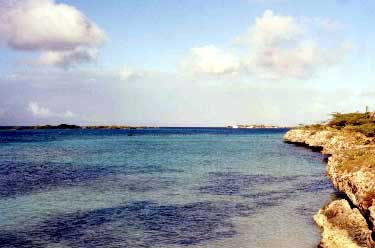Tiempo Climate Cyberlibrary
Adaptation - a Caribbean View
- Tiempo archive
- Complete issues
- Selected articles
- Cartoons
- Climate treaty
- Latest news
- Secretariat
- National reports
- IPCC
About the Cyberlibrary
The Tiempo Climate Cyberlibrary was developed by Mick Kelly and Sarah Granich on behalf of the Stockholm Environment Institute and the International Institute for Environment and Development, with sponsorship from the Swedish International Development Cooperation Agency.
While every effort is made to ensure that information on this site, and on other sites that are referenced here, is accurate, no liability for loss or damage resulting from use of this information can be accepted.
 |
Neville Trotz argues that responding to climate change requires increasing current resilience to climate variability. |
|
The author spearheads Caribbean efforts to build capacity for adaptation to climate change under the auspices of projects funded by the Global Environment Facility and the Canadian International Development Agency. |
|
The Barbados Programme of Action, articulated at the Small Island Developing States (SIDS) Conference (1994), identified climate change as a priority issue for the small island and low lying coastal Caribbean states. Caribbean countries have focused their response to this threat on building national capacity for adaptation, while pressing at international fora for increased mitigation efforts from Annex 1 countries.
Disasters threaten development efforts in the region by diverting scarce development resources to disaster response activities. Most disasters are linked to climate, and underline the existing vulnerability of the region to climate variability. Floods, droughts, forest fires and landslides are all associated with the El Niño phenomena.
|
|
Coastline of Aruba |
Average regional annual temperatures increased by at least 0.5 degrees C between 1900 and 1995. Precipitation is decreasing, and sea level rise threatens coastal areas, where most people live and work. Although the extent of future climate change risk is unclear, it is certain that climate change will exacerbate present-day regional vulnerability to climate variability. Serious loss of lives and livelihoods from recent heavy rainfall and floods in Haiti and the Dominican Republic provide evidence of this.
Immediate action is required to increase current resilience to risks arising from climate variability in order to improve capacity to respond to long-term climate change and ensure sustainable development in the region.
Adaptation in the region is informed by the urgent need to respond to risks arising from climate variability. This approach has been adopted by the GEF-funded Caribbean Planning for Adaptation to Climate Change project, and the preparation of National Adaptation Plans of Action. Regional and national consultations have improved understanding of perceptions of vulnerability to climate variability, capacity to cope and effective current responses.
We have learnt that adaptation is not a novel science; many solutions (such as Integrated Coastal Zone Management, Integrated Water Resources Management, Land Use Planning) have existed for some time. Only the resources and the commitment to implement them are missing. The need to institute and finance these solutions becomes more urgent with the threat of climate change.
Most SIDS suffer from a lack of capacity and limited availability of data for rigorous climate and vulnerability studies. The ‘bottom-up’ approach to adaptation, therefore, provides a valuable alternative to approaches now in vogue. The region looks forward to the availability of resources to facilitate reduction of vulnerability to climate variability - a legitimate approach to the longer-term goal of adaptation to climate change.
Comment
You can comment on this article by visiting the
Tiempo Climate Newswatch Forum.
Further information
Neville Trotz, ACCC Project Implementation Unit, Lazaretto
Complex, Black Rock, St Michael, Barbados. Fax: +246
4170461. Email: trotzcpacc@sunbeach.net.
On the Web
The Tiempo Climate Cyberlibrary lists
Small Island States websites.
Bright Ideas

General Electric plans to cut solar installation costs by half

Project 90 by 2030 supports South African school children and managers reduce their carbon footprint through its Club programme

Bath & North East Somerset Council in the United Kingdom has installed smart LED carriageway lighting that automatically adjusts to light and traffic levels

The United States National Oceanic and Atmospheric Administration and the American Public Gardens Association are mounting an educational exhibit at Longwood Gardens showing the link between temperature and planting zones

The energy-efficient Crowne Plaza Copenhagen Towers hotel is powered by renewable and sustainable sources, including integrated solar photovoltaics and guest-powered bicycles
El Hierro, one of the Canary Islands, plans to generate 80 per cent of its energy from renewable sources

The green roof on the Remarkables Primary School in New Zealand reduces stormwater runoff, provides insulation and doubles as an outdoor classroom

The Weather Info for All project aims to roll out up to five thousand automatic weather observation stations throughout Africa

SolSource turns its own waste heat into electricity or stores it in thermal fabrics, harnessing the sun's energy for cooking and electricity for low-income families

The Wave House uses vegetation for its architectural and environmental qualities, and especially in terms of thermal insulation

The Mbale compost-processing plant in Uganda produces cheaper fertilizer and reduces greenhouse gas emissions

At Casa Grande, Frito-Lay has reduced energy consumption by nearly a fifth since 2006 by, amongst other things, installing a heat recovery system to preheat cooking oil
Updated: May 15th 2015
